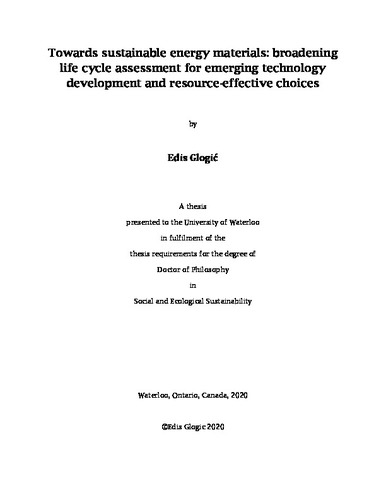| dc.description.abstract | Energy materials are particularly important from a sustainability perspective for advancing renewable energy systems, including energy production and storage. Their appropriate use and development require quantitative assessment methods. Life Cycle Assessment (LCA) is a method to support sustainable development that can be used to identify environmental hotspots and compare different technologies. The purpose of this research is to support development of several energy materials and make LCA a more relevant tool for sustainability assessment by extending its use in two emerging directions: assessment of technologies at the early stage of development, and by supporting more resource-effective choices for a circular economy.
The research objectives focus on informing the development of technologies and identifying methodological challenges and opportunities by applying LCA to three energy-technology case studies, each at a different technological maturity level. In the first case study, alkaline batteries, currently at a high maturity level (incumbent products), are evaluated using LCA in combination with a circular economy indicator, the Material Circularity Indicator (MCI). The aim was to investigate opportunities to combine the two methods, while considering trade-offs between indicators for different strategies for battery design and management. In the second case study, nickel-cobalt hydroxide charge storage electrodes, currently at a low maturity level (laboratory-scale), are evaluated to investigate environmental hotspots and preferred synthesis route. In the third case study, organic photovoltaic portable chargers for small electronics, currently at a medium maturity level (pilot-scale), are evaluated for replacing conventional electricity grid for charging a mobile phone.
The results of the alkaline batteries case study show the value and meaning of the MCI circular economy indicator to evaluate resource strategies as compared to LCA category and indicator results. In this context, an approach for combining and presenting the MCI indicator is proposed, and a need to improve characterization of material quality losses of secondary (recycled) material was identified. The electrodes case study offers insights on the environmental hotspots and relative status among technology alternatives, including the benefit of certain process stages and synthesis routes. The most favorable operating parameters in terms of current density and device lifetime expectations are identified. The analysis of photovoltaic chargers shows their environmental-performance potential given the geographical and use-intensity contexts. The chargers have shown as potentially valuable substitutes to local electricity grids in three of six countries given frequent use, and for specific impact categories. Case studies on electrodes and chargers demonstrate uncertainties in relation to allocation of reference flow to functional unit, which are addressed conducting scenario and break-even analysis. Given challenge and carried out responses, involve increasing efforts in the interpretation phase of LCA, an observation with potentially broader implications to the assessment of emerging technologies in LCA.
Further research should consider how circular economy indicators and could be used with and complement quantitative assessment methods such as LCA. In the context of LCA of emerging technologies, it is recommended that more emphasis is given to further classification of future-oriented LCA studies of emerging technologies, in order to better frame and organize methodological advancements in this area. A recommendation is also made in consideration to application of attributional and consequential LCA approaches in guiding technology development at different stages of technological maturity. | en |

